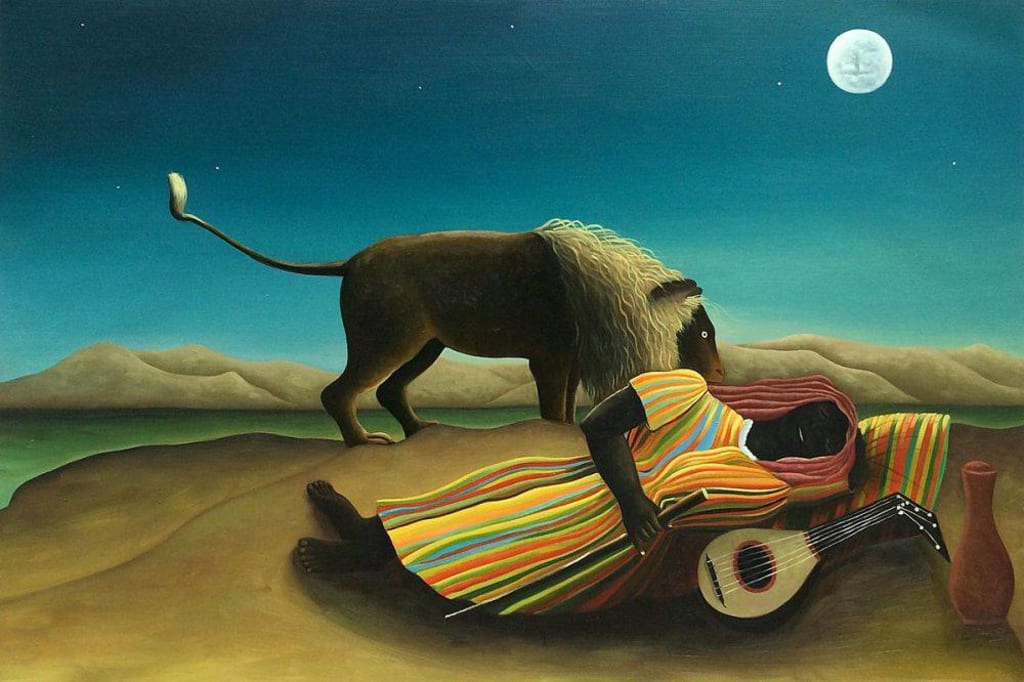The Sleeping Gypsy, by Henri Rousseau
A strange and haunting work of art

Henri Rousseau (1844-1910) was a largely self-taught French artist whose work was highly distinctive and very different from that of his contemporaries, particularly the Impressionists. There are elements in Rousseau’s work that are a foretaste of Dadaism and Surrealism, and he was greatly admired, late in his career, by artists such as Braque and Picasso.
Rousseau painted largely from the imagination, and many of his works are dream-like in composition with bizarre images and details. There are many technical imperfections in his work, and he was not good at portraying depth or perspective. As a result, his paintings often seem flat and static. However, on occasion he could produce something that was haunting and memorable, even with its faults. “The Sleeping Gypsy” (1897) is a case in point.

This painting dates from a time when Rousseau was beginning to achieve recognition from the art world after almost two decades of trying and failing to do so. He had a much higher opinion of his abilities than did most of his contemporaries, and had described himself two years previously as being “in the process of becoming one of our best realist painters”, which is an interesting statement in light of his use of the term “realist”. Granted, his subject matter is far removed from the classical prototypes of the more academic artists of the time, but Rousseau’s subjects and ways of painting them stretched the notion of realism further than most people would be prepared to go.
In “The Sleeping Gypsy” a young black woman, wearing a striped dress, lies on her side in a desert, with her head on a striped cushion. She has a stick grasped in her right hand, despite being asleep, and there is also a mandolin and a water jug on the ground beside her.
However, the most striking thing about his picture is the lion that occupies the centre of the canvas. The lion is standing still, looking at the woman with one round, bright eye. Its tail stands stiffly out behind it, the tuft at the end sticking upwards.
The scene is lit by a full moon, seen at the top right-hand corner of the picture, the light of which catches the lion’s mane and the fur on the edges of its back, legs and tail. The green-blue sky, the distant mountains beyond a lake, and the sand in the foreground are all bathed in its light with the colours graded in a technically impressive way.
Rousseau is best known today for his jungle scenes, in which thousands of leaves and blades of grass were painted virtually identically, in an almost obsessive way. Here, the obsession has transferred to the strips of colour on the woman’s dress, the braids of her strangely-coloured (pink) hair and the individual strands of the lion’s mane. Everything is sharply defined, with no suggestion of movement. There is no hint that anything has happened, or is about to happen.
The only lions that Rousseau would have seen in his entire life were zoo animals, as there is no evidence that he ever set foot outside France. When visiting the zoo he clearly did not take a sketchpad with him, because this lion is a very odd animal indeed. Its face is that of a sheep, and its mane consists of strands that grow forwards from a point somewhere near its shoulders.
Another oddity is how the lion is standing, with its front feet out of sight behind the dune on which the woman is lying. However, the lion appears to be staring straight at her face. There is therefore an Escher-like quality about this painting in its impossibility.
However, leaving aside its obvious faults, “The Sleeping Gypsy” is a powerful painting in its portrayal of innocence and calm beauty. The woman is defenceless, yet the lion poses no threat and is merely curious. The stillness is haunting and atmospheric, and the scene is from another world, that of the imagination, in which the unlikely combination of objects and main subjects is entirely appropriate. There is magic in the air, as there is in much of Rousseau’s work, and the painting is not let down by any technical “painterly” flaws as there often is when Rousseau’s skills are found wanting.
Henri Rousseau is usually described as a “naïve” or “primitive” artist, but it is his lack of sophistication that is the most attractive feature of his work, along with the surreal elements that are apparent in this painting and many others. Rousseau’s own innocence and self-belief come through strongly in “The Sleeping Gypsy”, a painting that is both touching and beautiful.
“The Sleeping Gypsy” is quite a large canvas, measuring 200 centimetres (79 inches) by 130 centimetres (51 inches) and it can be seen at the Museum of Modern Art (MoMA), New York.
About the Creator
John Welford
I am a retired librarian, having spent most of my career in academic and industrial libraries.
I write on a number of subjects and also write stories as a member of the "Hinckley Scribblers".
Reader insights
Outstanding
Excellent work. Looking forward to reading more!
Top insight
Eye opening
Niche topic & fresh perspectives






Comments
There are no comments for this story
Be the first to respond and start the conversation.